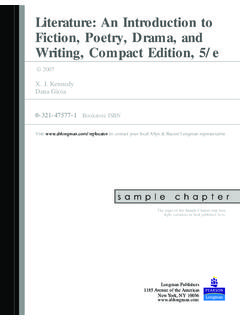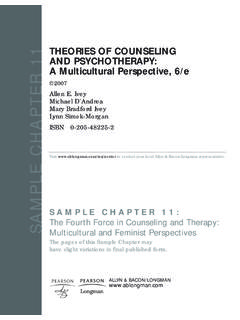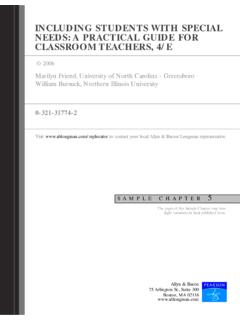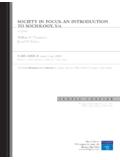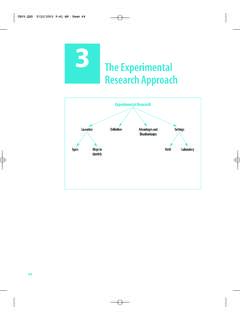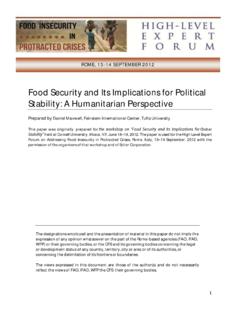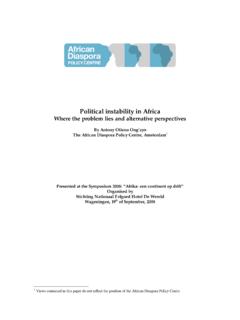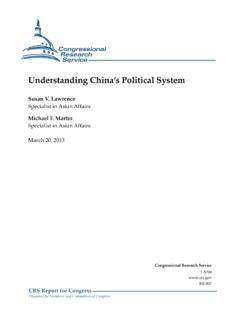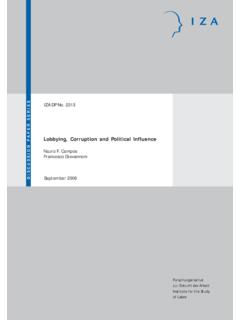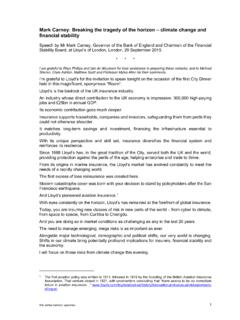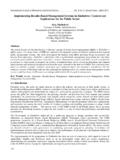Transcription of STRUCTURALISM AND DEPENDENCY - ablongman.com
1 419 CHAPTER 15 STRUCTURALISM AND DEPENDENCYINTRODUCTIONThis chapter examines why many Latin American countries whose economic devel-opment until the Second World War had been shaped overwhelmingly by agricul-ture and mining embarked on strategies that, instead, made industrialization a toppriority. It looks at the main economic argument that justified this policy shift, called STRUCTURALISM , and the profound implications this would have for the stateand the character of politics in Latin America. The strategies proposed and adoptedby economists to exploit a country s resources are of great importance to the waysin which social and political systems evolve. They determine who will be the mainwinners in a process of economic development and who will be the losers. In turn, they shape the nature of the state and the behaviour of the political actors whoseek to influence its policymaking role.
2 Until the 1930s the model of developmentin Latin America had been dominated by a small, landowning oligarchy controllingagricultural production on vast estates. This model of development found its mainpolitical reflection in systems that excluded all but the elite from policymaking andin extreme levels of inequality. However, ideas that came out of the Great Depres-sion eventually led to a transformation in the structure of the region s economiesthat placed a priority on industry. Industrialization nurtured a form of development that benefited urban social sectors and eroded the power of traditional landowners,but continued to exclude the peasants. It found new institutional expressions in Learning outcomesAfter reading this chapter, you should be able to:lExamine why Latin American countries began to the core principles of structuralist ideas that the strategy of import-substitution industrialization and its the DEPENDENCY approaches that emerged out of the relationship between industrialization and LATIN AMERICA420the emergence of unwieldy, centralizing states comprising large, bureaucratic minis-tries, and political expressions in the populism and corporatism that allowed elites dominating these states to maintain a core body of support to ensure stability (seeChapters 2, 6, 8, 13).
3 However, like the models that had preceded it, rapid indus-trialization generated social and political strains and began to run out of steam. Theexclusion of large numbers of people from the benefits it promised and from the coalitions by which it was maintained fuelled unrest. Millions of peasants abandonedthe countryside and headed for the city, swelling urbanization. Radical economic per-spectives based on the theme of dependence gained force in the ideologically tenseCold War atmosphere. political alternatives developed outside the formal institutionsof politics and sought new sources of support in the countryside and among the urban poor. These stresses all contributed to authoritarian clampdowns by militaryregimes at a time when industrialization had begun to falter. Once again, this setback the achievement of EXPORT-LED GROWTH TO INDUSTRIALIZATIONB efore the Great Depression many policymakers and economists in Latin Americahad believed that the region s best prospects for growth could be found in export-ing commodities that could be produced in abundance in their mainly agriculturaland mining economies then sold to the growing industrial countries of Europe andto the US.
4 This position was supported by the theory of comparative advantage in international trade, an influential doctrine that originated with the British eco-nomist David Ricardo ( ). The notion of comparative advantage sug-gests that a country will gain the greatest economic benefit in a trading relationshipwith other countries by concentrating its production on commodities that it can pro-vide at a lower overall cost, either because these are found in relative abundance orthey can be produced relatively easily within its territory. In turn, other countries in a trading relationship are themselves better off if they accept the cost advantagethe first country may have in producing that commodity, and themselves concen-trate on producing other commodities in which they have advantages. Comparativeadvantage is the main basis for most economists belief in free trade internationaltrade as free as possible from nationally imposed barriers such as tariffs and quotason imports and exports.
5 It is an important principle in economics because it impliesan international division of labour in which some countries stick to producing agri-cultural or mineral commodities for sale to others that produce industrial advantage and free trade are also important elements of the philosophyof economic liberalism, which places a premium on the benefits of free enterpriseconducted within markets unimpeded by artificial barriers imposed by Argentina, Latin America s most prosperous economy by the early twentiethcentury, such ideas appeared to make sense and the country s role in the internationalSTRUCTURALISM AND DEPENDENCY421economy as a supplier of agricultural commodities and raw materials from mining(together known as primary products ) seemed natural. These ideas suggested thatArgentina was best served by concentrating on the production and sale of beef, whichcould be produced intensively and cheaply from huge herds of cattle grazing on thevast pampas plains, and exchanged in a free international market with the highestor most reliable bidder in return for imported manufactured products.
6 After all, untilthe Depression such a model had delivered unprecedented rates of growth and evensmall socialist organizations did not question the bias in favour of export-led agri-cultural production. This economic model had nurtured the development of distinctivepolitical systems based on the exclusion of the vast majority of people (see Box )BOX SOCIETYE xport-led growth and the politics of exclusionThe most important political and social characteristics of societies with export-ledeconomies, such as those of Latin America, were inequality and exclusion. This isbecause the main beneficiary of export growth was a powerful oligarchy comprisinglarge landowners and merchants who tried to maintain their control over politics intheir own interests well into the 1920s. In Argentina, for example, ranchers and exportmerchants worked hard to exclude others from politics, and political institutions weredesigned and administered by these powerful groups to support the main objectives of an economic model that benefited them.
7 The main losers from Latin America s role in the international division of labour as a producer of agricultural goods andraw materials were poorly paid rural workers, many of whom began to head for thegrowing cities to find a better living, fuelling urbanization. At the same time, economicgrowth created new, mainly urban middle-class professionals, bureaucrats, shopkeepersand small businessmen (see Chapter 1). The spontaneous development of smallindustries and mines, and increases in immigration, led to the emergence of a smallworking class. Growing urban populations did not fit easily into the social hierarchy thathad supported the development of large estates and ranches for export-led growth, andtended to be more politically volatile than rural populations. As a result, the model ofexport-led growth adopted across Latin America generated new class tensions and insome countries such as Mexico, the continuing exclusion of the middle classes and ruralpoor led to agitation and political conflict (see Box ).
8 The pressures generated by export-led growth helped to undermine the control ofthe oligarchs across much of Latin America, and political systems were in transitionfrom the 1920s as elements of the oligarchy saw the need to incorporate the middleclasses and workers into the policymaking process. Middle-class politicians oftenassumed nationalist positions that attacked foreign interests while advocating greaterstate intervention in the economy to ensure a fairer distribution of resources. Althougholigarchical governments began to adapt by advocating more nationalist policies thatproposed protectionism the introduction of restrictions such as tariffs or quotas onsome imports in order to favour local producers it was the Great Depression thatprovided the stimulus for influential new ideas that would transform the economies andpolitics of Latin America (see Chapter 2).POLITICS LATIN AMERICA422 The Great Depression that followed the Wall Street crash of 1929 hit LatinAmerica hard as demand for its products withered and its ability to pay for importsdeclined, causing recessions and fuelling the growth of radical ideas and political unrest.
9 The Depression forced Latin American countries to reconsider their relation-ship with the international economic system, with some thinkers arguing that theregion had been forced into a disadvantaged position in the global division of particular, policymakers became aware of the need to reduce their reliance on theexport of commodities and the import of manufactured goods, and in the 1930s mostcountries in the region took the first steps towards nurturing their own industriesthrough import-substitution industrialization (ISI, see Chapter 2). They began to restructure their economies by adopting protectionist policies in order to protect localindustries from foreign competition, and this was made easier by the nationalist climate of the period that justified hostility to foreign economic activities. Some countries, such as Brazil, adopted policies that had, by the Second World War,allowed them to achieve substantial industrial growth.
10 This early industrializationcoincided with a growing interest in Keynesianism the body of economic thoughtdeveloped by the British economist John Maynard Keynes ( ) thatadvocated a greater role for the state in economic development and with theapparent successes of central planning in the Soviet Union. These ideas all contri-buted in the 1940s to the emergence of the new structuralist perspective in LatinAmerica advocating the need for countries to create industry in order to rely less onthe production of primary products. Structuralist ideas also represented a rejectionof influential perspectives that were developing in the industrialized world about how agrarian societies developed into modern industrial economies (see Box ).BOX THEORIES AND DEBATESM odernizationThe Marshall Plan pursued by the US following the Second World War pumped largeamounts of aid into the devastated countries of Europe, enabling them to rebuild andmodernize their economies in just a few years.


